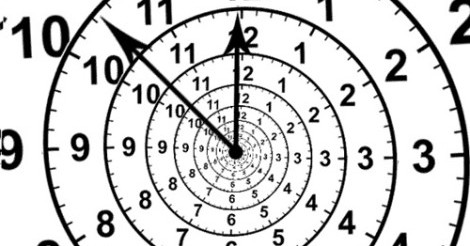

HC asks:
How would you describe time?
In Groundhog Day Phil Connors relives the same 24 hours continually, providing him limitless opportunities to correct his mistakes and live out the perfect day. It’s a tantalizing fantasy, an opportunity not to act without consequence but to select precisely those consequences we desire while removing any possibility of regret. While our spinning planet and its cyclical orbit give our lives a semblance of repetition, we can only experience each moment once. Effects follow causes; we must live in the future with all the intended and unintended results of our choices. We call this sequence of unrepeatable moments time. In other words, time is that feature of the universe which makes forgiveness necessary.
Explaining why the universe works in this irreversible fashion is the subject of much discussion. We don’t automatically move through space, but our march through time is inexorable. And why only forwards? The laws of physics are largely indifferent about the past and the future; the equations can be run both ways. Practically, that ambiguity means we can predict where a spaceship is going to be in the future or trace where it was in the past with equal ease and accuracy. Metaphysically, that ambiguity may mean the direction of time is more of a brute fact of the universe than a consequence of some elegant principles.
Time asymmetry does appear in the famous 2nd law of thermodynamics: total entropy can never decrease. We have only ever observed processes where entropy stays the same or increases (once you account for the whole system; entropy can decrease in one place by increasing elsewhere). Probability theory confirms that entropy increases are much more likely. Still, it’s not entirely clear whether time necessarily advances towards increasing entropy, or if we observe this asymmetry simply because the universe started in an extraordinarily low entropy state, leaving nowhere to go but up.
Another time asymmetry comes from quantum physics. Subatomic particles can become “entangled” with one another when they interact. If you start with two particles that you can describe fully on their own terms, after they interact a full description must include both particles as a unit. Information previously associated with each individual particle is now spread across both. This entanglement provides a direction; once that information spreads, you can’t make the particles forget about each other.
Looping back to forgiveness, think about a situation where you have wronged someone else. You might wish you could “rewind the tape,” choose differently and never have to deal with the mistake again because no one knows it happened. But that’s not how the universe works, even down to the smallest scale. When we wrong someone, they possess information about what we’ve done. We can’t erase that information; we can only move forward through forgiveness and redemption.
Andy has worn many hats in his life. He knows this is a dreadfully clichéd notion, but since it is also literally true he uses it anyway. Among his current metaphorical hats: husband of one wife, father of two teenagers, reader of science fiction and science fact, enthusiast of contemporary symphonic music, and chief science officer. Previous metaphorical hats include: comp bio postdoc, molecular biology grad student, InterVarsity chapter president (that one came with a literal hat), music store clerk, house painter, and mosquito trapper. Among his more unique literal hats: British bobby, captain’s hats (of varying levels of authenticity) of several specific vessels, a deerstalker from 221B Baker St, and a railroad engineer’s cap. His monthly Science in Review is drawn from his weekly Science Corner posts — Wednesdays, 8am (Eastern) on the Emerging Scholars Network Blog. His book Faith across the Multiverse is available from Hendrickson.

Leave a Reply